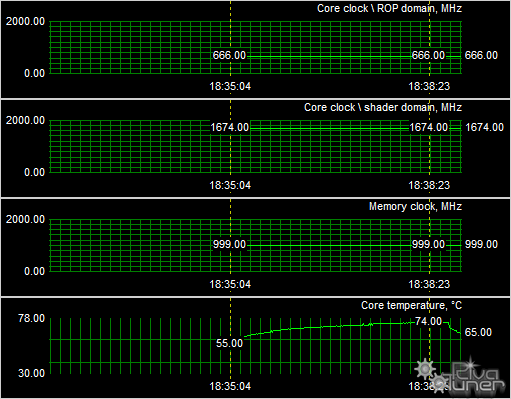13 - Overclocking the card with Call of Duty 4 results
Overclocking & Tweaking
As most of you with most videocards know, you can apply a simple series of tricks to boost the overall performance a little. You can do this at two levels, namely tweaking by enabling registry or BIOS hacks, or very simple, tamper with Image Quality. And then there is overclocking, which will give you the best possible results by far.
What do we need?One of the best tool for overclocking NVIDIA and ATI videocards is our own Rivatuner that you can download here. If you own an ATI or NVIDIA graphics card then the manufacturer actually has very nice built in options for you that can be found in the display driver properties.
Where should we go ?
Overclocking: By increasing the frequency of the videocard's memory and GPU, we can make the videocard increase its calculation clock cycles per second. It sounds hard, but it really can be done in less than a few minutes. I always tend to recommend to novice users and beginners not to increase the frequency any higher then 5% of the core and memory clock. Example: If your card runs at 600 MHz (which is pretty common these days) then I suggest you don't increase the frequency any higher than 30 to 50 MHz
More advanced users push the frequency often way higher. Usually when your 3D graphics start to show artifacts such as white dots ("snow"), you should back down 10-15 MHz and leave it at that. Usually when you are overclocking too hard, it'll start to show artifacts, empty polygons or it will even freeze. Carefully find that limit and then back down at least 20 MHz from the moment you notice an artifact. Look carefully and observe well. I really wouldn't know why you need to overclock today tested cards anyway, but we'll still show it ;)
All in all... do it at your own risk.
- The GeForce 9600 GSO is clocked at default at 550 / 1350 / 1600 clocks (core / shaders / memory).
- We overclocked it (easily) towards 666 / 1674 / 2000 (core / shaders / memory).
At 700 MHz the core locked after a few minutes of 100% load testing but hey; the one thing you'll absolutely like about the card is that it is an overclocker, and not a little'. A beasty 666 MHz core clock is a pretty nice overclock which brings in additional value as we can squeeze a little extra performance out of the product. Check out what happens when we fire op Call of Duty 4 again and compare the baseline performance versus the higher clocks. I've also inserted a default clocked GeForce 9600 GT to show you what happens.
Image Quality setting:
- 4x Anti Aliasing
- 16x anisotropic filtering
- All settings maxed out
 |
||
Overclocking results typically result into slightly more heat build-up in the GPU as well. Heavily stressed the core temperature rose towards ~74 degrees C. Nothing to worry about here, just make sure it doesn't pass 80-85 degrees C.
